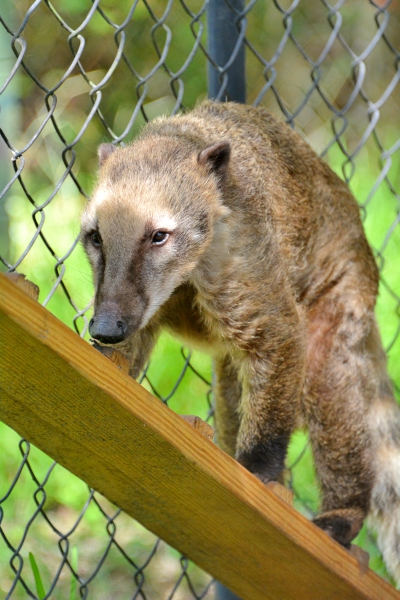Let’s swing the spotlight south of the border to look at the natural habitat of the coatimundis and how the ranch accommodates them. These relatives of the raccoon actually range as far north as Arizona and south through Argentina. Coatimundis are distinguished by their long snout and thick ringed tail. The snout enables them to search the ground fodder for food and the tail comes in handy for balance. The females are smaller and travel in groups called ‘bands’ that aggressively banish the males. The solitary males are then invited back in around March for a couple months of breeding. The pregnant female then finds a tree and builds her nest. After about a 75 day gestation period she will give birth to up to 7 babies (3 to 4 is most common). Bonding for about 5 to 6 weeks in the nest, she will then return to the ‘band’ with her young batch.

Now that you are familiar with them feel free to call them coatis. The name actually comes from the native Indian word for ‘nose’ and ‘belly’ and refers to the way they tuck their nose into their belly when they sleep. Along the way, they have picked up the reputation of being mischievous, and coincidentally, the ranch has a coati named Mischief. It may be a bad rap based on their intense curiosity and constant focused search for the easy feed. A foraging band of coati is noisy communicating their intent, preferences, and mood with grunts, snorts, chirps, and squeaks. And yes, the ranch has another coati named Squeakers. A third coati was born as a pet in South Florida in June of 2015 and brought to the Ranch shortly thereafter. He has been imaginatively named Cody. Rounding out the coati population at the Ranch is his roommate Callie. She is an older female that arrived at the Ranch in February 2011. She is easy going and doesn’t seem to mind being berthed with an adult male.
The four coatis at the Ranch represent a broad spectrum of the species. They present both sexes and a full range of color and facial patterns. Their activity levels indicate their ages as they go about their lives at the Ranch. It is essential to recall that this is their forever home and that volunteers at the Ranch endeavor to create a comfortable existence for them. The coatis may not be able to roam the forest from tree to tree as their ancestors do in their native land, but no longer do they fear the predators (including man) that are out to get them. All things considered, these very adaptable coatis appear happy with their lot here at the Ranch. Native type meals are provided along with an occasional slab of rotting wood to allow them to probe for hidden insects. Their enclosures have been designed to simulate, as much as is practical their native forest habitat.
Now, what can you do to make their lives more comfortable? They love blankets (and marshmallows). If you have any old blankets, just taking up space around the house, bring them in and the coatis will make good use of them. Experienced volunteers can recognize when it’s time to exchange the blankets. These same volunteers, with the vet’s approval, may also slip them a marshmallow.
For more info on each individual coatimundi go to the Catty Shack page and click on their picture in the RESIDENT section.


